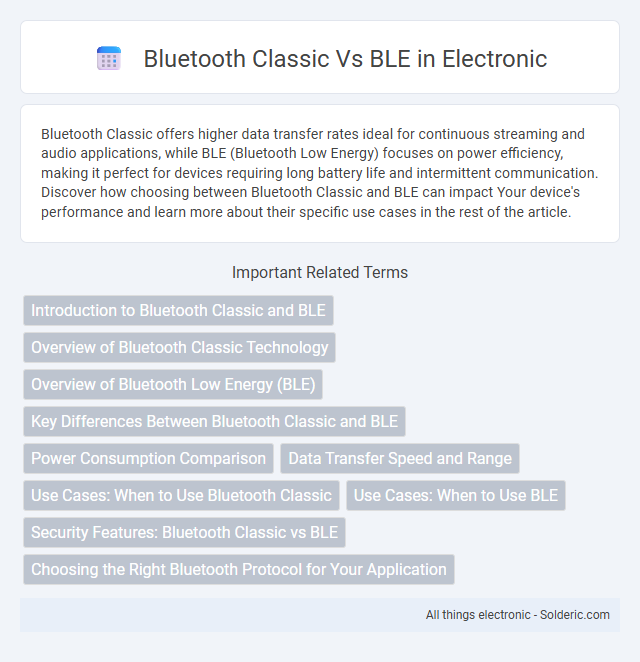Bluetooth Classic offers higher data transfer rates ideal for continuous streaming and audio applications, while BLE (Bluetooth Low Energy) focuses on power efficiency, making it perfect for devices requiring long battery life and intermittent communication. Discover how choosing between Bluetooth Classic and BLE can impact Your device's performance and learn more about their specific use cases in the rest of the article.
Comparison Table
| Feature | Bluetooth Classic | Bluetooth Low Energy (BLE) |
|---|---|---|
| Introduction Year | 1999 | 2010 |
| Power Consumption | High | Very Low |
| Data Rate | Up to 3 Mbps | Up to 2 Mbps |
| Use Case | Audio streaming, file transfer | IoT sensors, fitness trackers |
| Connection Setup Time | Longer (around 100 ms) | Shorter (less than 6 ms) |
| Range | Typically 10 meters | Typically 10-50 meters |
| Compatibility | Widely supported on legacy devices | Designed for new low power devices |
| Audio Support | Yes, supports audio streaming | No native audio support |
Introduction to Bluetooth Classic and BLE
Bluetooth Classic provides robust, continuous streaming for devices requiring higher data rates, ideal for audio and file transfer applications. Bluetooth Low Energy (BLE) optimizes power consumption for intermittent data transmission, making it perfect for IoT sensors and wearable technology. Understanding these key differences helps you choose the best Bluetooth technology for your specific connectivity needs.
Overview of Bluetooth Classic Technology
Bluetooth Classic technology, also known as Bluetooth BR/EDR (Basic Rate/Enhanced Data Rate), provides robust wireless communication primarily for audio streaming, file transfers, and device connectivity with higher data rates up to 3 Mbps. It operates in the 2.4 GHz ISM band, supporting continuous, reliable connections ideal for devices like wireless headphones, car kits, and game controllers. Your choice of Bluetooth Classic ensures stable, low-latency performance for applications requiring sustained data throughput and compatibility with a broad range of legacy devices.
Overview of Bluetooth Low Energy (BLE)
Bluetooth Low Energy (BLE) is a power-efficient wireless communication technology designed for short-range data exchange with significantly reduced energy consumption compared to Bluetooth Classic. It is optimized for applications like fitness trackers, smart home devices, and medical sensors that require intermittent data transmission and prolonged battery life. Your devices benefit from BLE's ability to maintain connectivity while minimizing power use, making it ideal for IoT and wearable technology.
Key Differences Between Bluetooth Classic and BLE
Bluetooth Classic offers continuous streaming with higher data rates up to 3 Mbps, making it ideal for audio and file transfers, while Bluetooth Low Energy (BLE) prioritizes low power consumption with data rates around 1 Mbps for intermittent data exchange and sensor applications. Bluetooth Classic uses frequent connections that drain more battery, whereas BLE maintains low energy usage through quick connection intervals and sleep modes. Your choice between Bluetooth Classic and BLE depends on balancing data throughput needs against power efficiency for your specific device or application.
Power Consumption Comparison
Bluetooth Classic typically consumes more power due to its continuous connection and higher data rate requirements, making it less ideal for battery-powered devices. BLE (Bluetooth Low Energy) is designed for minimal power usage by using short bursts of data transmission and extended sleep modes, significantly extending device battery life. In scenarios requiring prolonged operation with infrequent data transfer, BLE offers superior power efficiency compared to Bluetooth Classic.
Data Transfer Speed and Range
Bluetooth Classic offers higher data transfer speeds up to 3 Mbps, making it suitable for applications requiring continuous streaming such as audio playback. BLE (Bluetooth Low Energy) prioritizes power efficiency with data rates up to 2 Mbps but operates over longer ranges, reaching up to 240 meters in optimal conditions. Your choice between Bluetooth Classic and BLE depends on whether speed or extended range is more critical for your device's connectivity needs.
Use Cases: When to Use Bluetooth Classic
Bluetooth Classic excels in high-bandwidth applications such as audio streaming, wireless headphones, and hands-free calling where continuous data transfer is essential. Your devices benefit from Bluetooth Classic when prioritizing reliable, sustained connections for peripherals like keyboards, mice, and printers. This technology supports legacy compatibility and robust performance in environments requiring uninterrupted data flow.
Use Cases: When to Use BLE
Bluetooth Low Energy (BLE) is ideal for applications requiring minimal power consumption, such as fitness trackers, smartwatches, and IoT sensors that need to run for extended periods on small batteries. BLE's quick connection times and efficient data transfer make it suitable for intermittent data transmissions in healthcare devices, asset tracking, and proximity sensing. Devices that demand continuous audio streaming or high data throughput benefit more from Bluetooth Classic, whereas BLE excels in energy-sensitive and low-bandwidth use cases.
Security Features: Bluetooth Classic vs BLE
Bluetooth Classic offers robust security features including authentication, encryption, and authorization, supporting legacy pairing methods such as PIN codes and Secure Simple Pairing (SSP). Bluetooth Low Energy (BLE) enhances security with the LE Secure Connections protocol based on Elliptic Curve Diffie-Hellman (ECDH) for stronger encryption and protection against passive eavesdropping and man-in-the-middle attacks. BLE also incorporates improved privacy features like resolvable private addresses to reduce tracking risks, making it more suitable for modern IoT applications requiring advanced security.
Choosing the Right Bluetooth Protocol for Your Application
Bluetooth Classic offers high data transfer rates and robust audio streaming, making it ideal for applications like wireless headphones and car audio systems. BLE (Bluetooth Low Energy) prioritizes power efficiency and is suited for devices requiring long battery life and intermittent data transmission, such as fitness trackers and smart home sensors. Selecting the right Bluetooth protocol depends on your application's data throughput needs, power consumption constraints, and latency requirements.
Bluetooth Classic vs BLE Infographic

 solderic.com
solderic.com